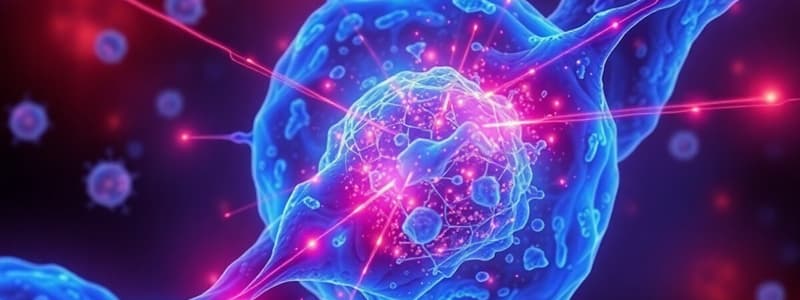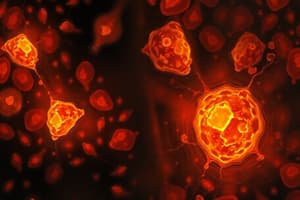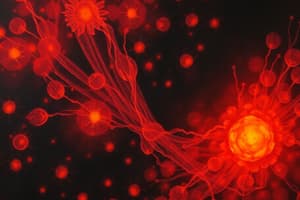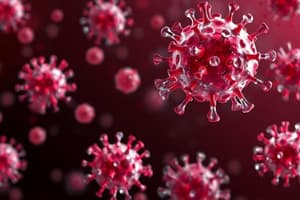Podcast
Questions and Answers
What is the primary function of the immunological synapse?
What is the primary function of the immunological synapse?
- To regulate apoptosis in T cells
- To enhance the release of cytokines only
- To facilitate communication between T cells and antigen-presenting cells (correct)
- To eliminate T cells that do not respond to antigens
Which co-stimulatory molecule is specifically associated with CD4+ T cells?
Which co-stimulatory molecule is specifically associated with CD4+ T cells?
- CD58
- 4-1BB
- CD28
- CD40 (correct)
What signals are necessary for T cell activation?
What signals are necessary for T cell activation?
- Intracellular signaling only
- First and second signals involving an immunological synapse (correct)
- Signals from other immune cells only
- Only cytokines from B cells
What role do ITAMs play in T cell signaling?
What role do ITAMs play in T cell signaling?
How do CD4+ T cells and CD8+ T cells differ in their maturation and activation?
How do CD4+ T cells and CD8+ T cells differ in their maturation and activation?
Which cytokine is essential for the proliferation and differentiation of activated naive T cells?
Which cytokine is essential for the proliferation and differentiation of activated naive T cells?
What happens to CD8+ T cells if they are missing CD28 during activation?
What happens to CD8+ T cells if they are missing CD28 during activation?
Which of the following statements about memory T cells is true?
Which of the following statements about memory T cells is true?
What is the main purpose of the immunological synapse?
What is the main purpose of the immunological synapse?
Which two signals are essential for the activation of naive T cells?
Which two signals are essential for the activation of naive T cells?
What are immunoreceptor tyrosine-based activation motifs (ITAMs)?
What are immunoreceptor tyrosine-based activation motifs (ITAMs)?
What triggers tolerance/anergy in T cells?
What triggers tolerance/anergy in T cells?
Which structure within the immunological synapse is primarily associated with receptor signaling?
Which structure within the immunological synapse is primarily associated with receptor signaling?
How do CD4+ and CD8+ T cells differ in their activation processes?
How do CD4+ and CD8+ T cells differ in their activation processes?
What role do co-stimulatory signals play in T cell activation?
What role do co-stimulatory signals play in T cell activation?
What happens when both the first signal and second signal are delivered along with cytokines?
What happens when both the first signal and second signal are delivered along with cytokines?
What is the primary determinant of whether a thymocyte matures into a CD4+ or CD8+ T cell?
What is the primary determinant of whether a thymocyte matures into a CD4+ or CD8+ T cell?
How do T cells with high-affinity T-cell receptors (TCRs) for self-MHC/peptide complexes typically respond during negative selection?
How do T cells with high-affinity T-cell receptors (TCRs) for self-MHC/peptide complexes typically respond during negative selection?
Which process allows T cells to leave the thymus and enter peripheral circulation after maturation?
Which process allows T cells to leave the thymus and enter peripheral circulation after maturation?
What role do ITAMs play in T cell signaling?
What role do ITAMs play in T cell signaling?
What triggers the process of anergy in T cells?
What triggers the process of anergy in T cells?
Which of the following statements correctly compares CD4+ and CD8+ T cell activation?
Which of the following statements correctly compares CD4+ and CD8+ T cell activation?
What is the primary function of the immunological synapse?
What is the primary function of the immunological synapse?
What best describes the 'homing' mechanism of T cells to secondary lymphoid tissues?
What best describes the 'homing' mechanism of T cells to secondary lymphoid tissues?
Flashcards are hidden until you start studying
Study Notes
Naive T cell activation
- After negative selection, T cells are mature and leave the thymus
- Both CD4+ and CD8+ T cells require a "first" and "second" signal for activation
- The "first" signal comes from TCR/CD4 and p:MHC class II complex on dendritic cell
- The "second" signal comes from CD28 co-stimulatory receptor & B7 (CD80/86)
- *CD40 & CD40L are key co-stimulatory molecules for CD4+ cells
- *4-1BB & 4-1BBL are key co-stimulatory molecules for CD8+ cells
- CD58 can also stimulate CD8+ T cells if CD28 is missing
- The first signal alone leads to tolerance/anergy
- First + second signal = Activation
- First + second signal + cytokines = Effector function
- If only the first signal is received, the T cell becomes tolerant, or anergic, and cannot be activated.
- The immunological synapse forms between a naive T cell and a dendritic cell
- It includes a central (c-SMAC) and peripheral (p-SMAC) supramolecular activation complex (c-SMAC)
- The c-SMAC mainly contains signaling molecules and the p-SMAC mainly contains adhesion molecules
Signal transduction
- The TCR and CD4 co-receptor bind to the p:MHC class II complex on the dendritic cell, delivering the first signal for T cell activation
- The CD28 co-stimulatory receptor on the T cell binds to the B7 (CD80/86) co-stimulator on the dendritic cell, delivering the second signal for T cell activation
- ITAMs (immunoreceptor tyrosine-based activation motifs) are conserved sequence that are repeated twice in the cytoplasmic tails of the TCR.
- They initiate intracellular immune signaling and activation of immune cells
- IL-2 is a cytokine that drives proliferation and differentiation of activated naive T cells
CD4+ and CD8+ T cell Maturation and Activation
- Both CD4+ and CD8+ T cells mature in the thymus and become single positive during positive selection
- CD4+ cells mature and differentiate into various subsets based on their role with different cytokine production
- The most important subtypes are TH1, TH2, TH17, Treg and Tfh
- CD8+ cells differentiate into cytotoxic T lymphocytes (CTLs)
- Their activation and differentiation depend on antigen presentation and cytokine signaling
- CD8+ cells are able to kill infected cells that present viral or tumor antigens
Immunological synapse
- It is an ordered structure that functions as an immunological synapse
- The immunological synapse is formed when two immune system cells bind with receptors and adhesion molecules
- It allows the exchange of signals and the secretion of effector molecules
Homing & Trafficking
- Homing refers to the process of T cells migrating from the thymus to secondary lymphoid tissues
- Lymphocyte trafficking is the movement of lymphocytes between different tissues
- They are regulated by chemokines, adhesion molecules and homing receptors that are expressed on the surfaces of lymphocytes
- T cells use chemokines to find their way to lymph nodes where they can encounter antigens.
- chemokines are specific for different lymphoid organs, providing precise guidance for homing.
Dendritic cell maturation and antigen presentation
- Dendritic cells act as antigen-presenting cells (APCs)
- They capture antigens and present them to T cells
- Maturation is a process that increases their ability to present antigens
- It involves changes in expression of MHC molecules, co-stimulatory molecules, and chemokine receptors
- During maturation, dendritic cells migrate from the tissues to the lymph nodes, where they can activate T cells
Memory T cells
- They are long-lived T cells that can rapidly respond to a re-exposure to a specific antigen
- They are generated from activated naive T cells during an immune response
- They provide long-term protection against pathogens
Importance and Significance of IL-2
- Interleukin-2 (IL-2) is a crucial cytokine that regulates T cell proliferation, differentiation, and survival
- It is mainly secreted by T cells (CD4+ and CD8+)
- It has different functions depending on the context and the stage of T cell activation
- IL-2 promotes the expansion of antigen-specific T cells
- It contributes to the establishment of memory T cells
- It also contributes to the suppression of immune responses
Central tolerance
- Ensures that T cells do not attack self-antigens or other antigens in the body
- It is established during thymic T cell development
- It is mainly mediated by negative selection
- It prevents the development of autoimmune diseases
Studying That Suits You
Use AI to generate personalized quizzes and flashcards to suit your learning preferences.




![Lecture 06: T-cells and B-cell activation [MCQ 2]](https://assets.quizgecko.com/cdn-cgi/image/width=300,height=200,fit=crop,quality=75,format=webp/quiz/3a994686d8bf59d60d02fc2aa264f493.jpg)